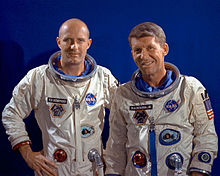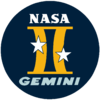This is an old revision of this page, as edited by SchuminWeb (talk | contribs) at 06:43, 13 April 2011 (→See also: rm redundant link). The present address (URL) is a permanent link to this revision, which may differ significantly from the current revision.
Revision as of 06:43, 13 April 2011 by SchuminWeb (talk | contribs) (→See also: rm redundant link)(diff) ← Previous revision | Latest revision (diff) | Newer revision → (diff)| This article needs additional citations for verification. Please help improve this article by adding citations to reliable sources. Unsourced material may be challenged and removed. Find sources: "Gemini 6A" – news · newspapers · books · scholar · JSTOR (May 2009) (Learn how and when to remove this message) |
| COSPAR ID | 1965-104A |
|---|---|
| SATCAT no. | 01839 |
| Crew | |
| Members | 2 |
| End of mission | |

 | |
Gemini 6A (officially Gemini VI-A) was a 1965 manned United States spaceflight in NASA's Gemini program. The mission achieved the first manned rendezvous with another spacecraft, its sister Gemini 7. Although the Soviet Union had twice previously launched simultaneous pairs of Vostok spacecraft, these established radio contact with, but came no closer than, several kilometers of each other, while Gemini 6A and 7 came as close as one foot (30 cm) and could have docked had they been so equipped.
Gemini 6A was the fifth manned Gemini flight, the 13th manned American flight, and the 21st manned spaceflight of all time (includes X-15 flights over 100 kilometres (62 mi).
Crew
| Position | Astronaut | |
|---|---|---|
| Command Pilot | Walter M. Schirra, Jr. Second spaceflight | |
| Pilot | Thomas P. Stafford First spaceflight | |
Backup crew
| Position | Astronaut | |
|---|---|---|
| Command Pilot | Virgil I. Grissom | |
| Pilot | John W. Young | |
Mission parameters
- Mass: 3,546 kilograms (7,818 lb)
- Perigee: 161 kilometres (100 mi)
- Apogee: 259.4 kilometres (161.2 mi)
- Inclination: 28.97°
- Period: 88.7 min
Stationkeeping with GT-7
- Start: December 15, 1965 19:33 UTC
- End: December 16, 1965 00:52 UTC
Objectives

The original Gemini 6 mission, scheduled for launch on October 25, 1965 at 12:41 pm EDT, had a planned mission duration of 46 hours 47 minutes, completing a total of 29 orbits. It was to land in the western Atlantic Ocean south of Bermuda.
The mission was to include four dockings with the Agena Target Vehicle. The first docking was scheduled for 5 hours 40 minutes into the mission. The second at 7 hours 45 minutes, the third at 9 hours 40 minutes and the fourth and final docking at 10 hours 5 minutes into the mission. The final undocking would take place at 18 hours 20 minutes into the mission.
At 23 hours 55 minutes into the mission, while the spacecraft passed over White Sands, NM, the crew were to attempt to observe a laser beam originating from the ground.
The retro rockets were scheduled to be fired at 46 hours 10 minuttes into the mission while over the Pacific Ocean on the 29 orbit.
Original mission plans also included the first live television coverage of the recovery of a US spacecraft at sea from the recovery ship, the US aircraft carrier Wasp. The Wasp was fitted with ground station equipment to relay live television, via the Intelsat I (nicknamed the "Early Bird" satellite).
However, after a control failure in the unmanned Agena target required its destruction six minutes after its liftoff (when the crew was already sitting in their capsule awaiting their launch), the mission was canceled.
Reviewing the situation, NASA decided to substitute an alternate mission: a meeting in space of two Gemini spacecraft. The new mission would be known as Gemini 6-A, and would launch eight days after the launch of Frank Borman's and Jim Lovell's Gemini 7.
| Gemini 6 | Agena Info |
|---|---|
| Agena | GATV-5002 |
| Mass | 3,261 kilograms (7,189 lb), 7800 lbs. |
| Launch site | LC-14 |
| Launch date | October 25, 1965 |
| Launch time | 15:00:04 UTC |
| Exploded | 15:06:20 UTC |
Flight

First launch attempt

The first launch attempt of Gemini 6A was on December 12, 1965 at 9:54AM EST. All went well right up to ignition—in fact the engines did ignite, but then a plug fell out of the bottom of the rocket, starting the onboard computer. This was not meant to happen until the rocket had actually lifted off, and the onboard computer detected that there was no upwards motion, causing it to abort the launch. At this point mission rules dictated that the crew should eject from the spacecraft, as the rocket would explode on impact with the pad if its trajectory was off by even an inch (2.54 cm).
Schirra elected not to eject as neither he nor Stafford had detected any upwards motion, and the ejection seats were seen as a last resort. In an early test of the system involving a dummy, the hatch had failed to blow off and the dummy's head was rammed into the side of the spacecraft. Also all ejection seats cause a dangerous compression of the spine as these were designed to carry the astronauts as quickly as possible (with the goal of evacuating the astronauts a couple of hundred meters away from an exploding rocket).
The Martin and Air Force teams who erected and tested the rocket found that some plugs on the rocket were able to pull out more easily than others. They replaced them with the ones that were harder to pull out on future missions, and a safety wire was added to make sure that the rocket had lifted off.
However, another problem was found as the engineers examined the thrust versus time graph. They found that the thrust rose nominally but started to get lower before the plug had fallen out. Through the night, engineers examined the rocket engine piece by piece until they found that a plastic cover had been left in the gas generator port. With this problem solved the rocket and spacecraft were rescheduled for a launch three days after the first attempt.
Rendezvous
The third attempt to launch Gemini Spacecraft Number 6 (second attempt for the 6A mission) was successful on December 15. All went well through launch and ascent and the crew entered a 161 by 259 kilometers orbit, or as per the actual flight specifications, a 100 by 161 mile orbit.
The plan called for the rendezvous to take place on the fourth orbit of Gemini 6A. Their first burn came 94 minutes after launch when they increased their speed by 5 meters per second, 16½ feet per second. Due to their lower orbit they were gaining on Gemini 7 and were only 730 miles, (or 1,175 kilometers), behind. The next burn was at 2 hours and 18 minutes when Gemini 6A made a phase adjustment to put them on the same orbital inclination as Gemini 7. They now only trailed by 483 kilometers, (300 miles).
The radar on Gemini 6A first made contact with Gemini 7 at 3 hours and 15 minutes when they were 434 kilometers, (270 miles) away. A third burn put them into a 168 x 170 mile (270 by 274 kilometer) orbit. As they slowly gained, Schirra put Gemini 6A's computer in charge of the rendezvous. At 5 hours and 4 minutes he saw a bright star that he thought was Sirius, but this was in fact Gemini 7.

After several more burns the two spacecraft were only 130 feet, (40 meters) apart. The burns had only used 112 lbs., (51 kilograms) of fuel on Gemini 6A, giving plenty of fuel for some fly arounds. During the next 270 minutes the crews moved as close as 1 foot, (30 centimetres), talking over the radio. At one stage the spacecraft were stationkeeping so well that neither crew had to make any burns for 20 minutes.
As the sleep periods approached Gemini 6A made a separation burn and slowly drifted out to 10 miles, (16 kilometers). This ensured that there wouldn't be any accidental collisions in the night.
A Christmas surprise
But before everyone went to sleep, the crew of Gemini 6A had a surprise for everyone:
Gemini VII, this is Gemini VI. We have an object, looks like a satellite going from north to south, probably in polar orbit…. Looks like he might be going to reenter soon. Stand by one…. You just might let me to pick up that thing…. I see a command module and eight smaller modules in front. The pilot of the command module is wearing a red suit.
At that point, the sound of "Jingle Bells" was heard played on an 8-note Hohner "Little Lady" harmonica and a handful of small bells. The Smithsonian Institution claims these were the first musical instruments played in space and keeps the instruments on display.
Reentry
Gemini 6A reentered the next day landing within 18 kilometres (11 mi) of the planned site northeast of Turks and Caicos in the Atlantic Ocean, the first truly accurate reentry. It was also the first to be televised live, through a transportable satellite earth station developed by ITT on the deck of the recovery aircraft carrier USS Wasp.
The Gemini 7 & 6A missions were supported by the following U.S. Department of Defense resources: 10,125 personnel, 125 aircraft and 16 ships.
Insignia
Walter Schirra explained the patch in his book All We Did Was Fly to the Moon:
The Gemini 6 patch is hexagonal in shape, reflecting the mission number; and the spacecraft trajectory also traces out the number "6". The Gemini 6 spacecraft is shown superimposed on the "twin stars" Castor and Pollux, for "Gemini". I designed the patch to locate in the sixth hour of celestial right ascension. This was the predicted celestial area where the rendezvous should occur (in the constellation Orion). It finally did occur there.
The original patch had called the flight G-T-A-6 (for Gemini-Titan-Agena) and showed the Gemini craft chasing an Agena. It was changed when the mission was altered.
Spacecraft location
The spacecraft is currently on display at the Oklahoma History Center in Oklahoma City, after having been on display at the Omniplex Science Museum elsewhere in the city. It is on a long term loan from the Smithsonian Institution. Before coming to Oklahoma, the spacecraft was displayed at the St. Louis Science Center in St. Louis, Missouri.
See also
References
- "Here Is The Condensed Flight Plan For Gemini 6", Williamson, WV Daily News, Oct 25, 1965
- "Live TV From Wasp For Gemini-6 Flight,", Pittsburgh Post-Gazette, Oct 22, 1965
- "Gemini 6 Space Shot Fails", Glasgow Herald, Oct 26, 1965
- "Toughest Space Assignment Yet By Gemini, They'll Try It Twice", Ocala Star-Banner, Oct 29, 1965
- Astronautix
- "NASA Mum on 'Jingling'", Palm Beach Post, Dec 17, 1965
- Smithsonian magazine, December 2005
External links
- NASA Gemini 6 press kit for cancelled mission - Oct 20, 1965
- NASA Gemini 7/Gemini 6 press kit - Nov 29, 1965
- Gemini 6 Mission Report (PDF) - October 1965 cancelled mission
- Gemini 6/Agena target vehicle 5002 systems test evaluation (PDF) December 1965
- On The Shoulders of Titans: A History of Project Gemini
- Spaceflight Mission Patches
- http://www.collectspace.com/news/news-092703a.html
- Archive footage (??) from British Pathé at YouTube
| Project Gemini | ||||||
|---|---|---|---|---|---|---|
| Missions |
|  | ||||
| Astronauts |
| |||||
| Components | ||||||
| Launch sites | ||||||
| Developments | ||||||
| Related | ||||||